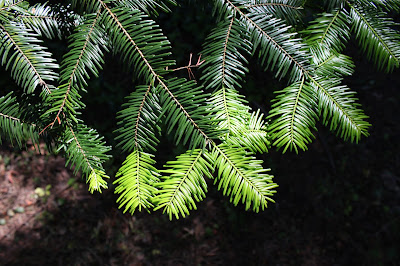|
|
 |
| Abies Grandis – Grand Fir |
It is an evergreen long tree. The
tree generally grows to 40–70 m (135 – 230 ft) in height. The new shoots are smooth and
olive-green. The buds are small, blunt, and resin-coated. The needles are long
(for firs), u to 2 inches, twisted at their base so as to spread in two ranks
in one plane; the upper rank has the shorter needles. They have notched apices,
and are glossy green above, with two prominent glaucous bands below. The new
pale green needles, which appear in June, fringe the edges of all the branches,
giving the tree its best appearance. When crushed, the scent is pleasantly
aromatic. When pulled away from the stem they leave a neat round scar, not a
peg.
Both sexes
of flowers are found on the same tree. The small yellow male flowers are in
clusters on the underside of the branches. The females are erect, short, scaly,
and yellow-green, borne height up on the tree and are thus seldom seen. On
fertilization they develop into erect cylindrical cones up to 4 inches long and
an inch or more broad, and slightly indented at the apex. They ripen to a
yellowish-green, and disintegrate in September leaving the persistent central
spike on the tree.
The bark is
smooth, with some blisters containing clear, aromatic resin. With age the bark
becomes dark-brown, fissured and scaly. The branches are in whorls, often wide
apart. The wood is white or pale cream in color, with no marked heart-wood. It
is used for box making, paper-pulp, and for general purposes where strength and
natural durability are not required. Sometimes a drought crack’ runs in spiral
fashion up the stem. The bark has historical medicinal properties, and it is
popular in the United States as a Christmas tree.
Foresters
prize ‘grandis’ as ‘a fast and heavy volume-producer of moderately strong
timber’ and as a useful under-plant. It can reach 40 m (130 ft) in fifty years.
The European
Silver Fir, Abies alba Mill., usually fails in some countries of Europe because
of attacks by tiny needle-sucking aphids, species of Adelges. Consequently it
is not only planted for timber but also little tree for ornament.
Video of Grand Fir:
 |
| Abies Grandis – Grand Fir |
 |
| Leaves of Grand Fir |
 |
| Leaves of Abies Grandis |
 |
| Abies Grandis Leaves |
 |
| Grand Fir Leaves |
 |
| Abies Grandis – Grand Fir |
 |
| Male Catkins of Grand Fir |
 |
| Female Cones of Grand Fir |
 |
| Bark of Grand Fir |
 |
| Logs of Grand Fir |
 |
| Long Trunk of Grand Fir |
 |
| Long Trunk of Abies Grandis |
 |
| Grand Fir as Christmas Tree |
 |
| Abies Grandis Plantation as Christmas Trees |
 |
| Grand Fir for Christmas Trees |
 |
| Abies Grandis for Christmas Trees |
 |
| Abies Grandis – Grand Fir |
Video of Grand Fir:
Christmas Tree
No comments:
Post a Comment